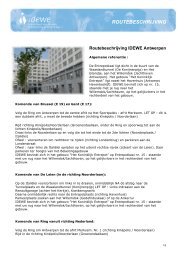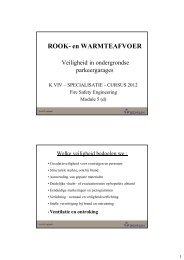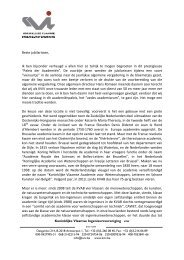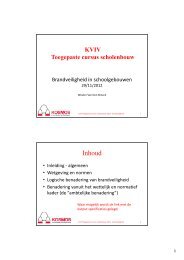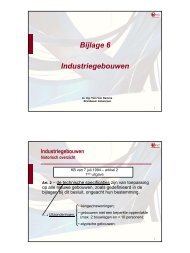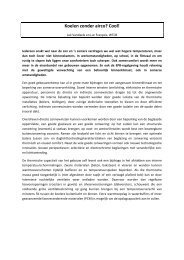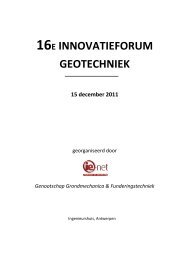Schoonbaert volledig - ie-net
Schoonbaert volledig - ie-net
Schoonbaert volledig - ie-net
Create successful ePaper yourself
Turn your PDF publications into a flip-book with our unique Google optimized e-Paper software.
An Updated International Survey ofComputer Models 97<br />
Fire Endurance Models<br />
Fire endurance models simulate the response of building structural<br />
elements to fire exposure. Some of these models are stand-alone, while<br />
others are incorporated into zone or f<strong>ie</strong>ld models. The concept of fire<br />
endurance models is the same as that of the f<strong>ie</strong>ld models. The structural<br />
object is divided into smaller volumes, and the equations for thermal heat<br />
transfer and mechanical behavior for solids are solved to determine when<br />
the structure will fail. Typically, the material propert<strong>ie</strong>s are required input<br />
for the model as well as the boundary conditions (i.e., the fire exposure) for<br />
the structural element.<br />
These models can be very useful for determining when a beam or column<br />
will deform or fail, and for solving for a temperature versus time curve at a<br />
certain depth inside the structural element. Since many structural elements<br />
are constructed differently, have different features, and have different<br />
practical applications, care must be used in selecting a model that properly<br />
characterizes the structural element.<br />
The number of fire endurance models identif<strong>ie</strong>d in this survey has<br />
increased by a factor of two as compared to the earl<strong>ie</strong>r survey [1]. This trend<br />
is again due to improved computer resources, allowing more complete and<br />
complex finite element calculations to be conducted on structural elements.<br />
Also, the trend towards performance-based design has led to more model<br />
creation for structural elements.<br />
Table 5 lists the fire endurance models identif<strong>ie</strong>d for the model<br />
survey.<br />
Miscellaneous Models<br />
The models which are not appropriate for one of the previous categor<strong>ie</strong>s<br />
or have features which fulfill more than one of the other categor<strong>ie</strong>s have<br />
been termed miscellaneous. Many of these models are computer programs<br />
which contain many submodels and therefore can be used for several of the<br />
categor<strong>ie</strong>s listed above. These are suites of programs which have several<br />
separate models which each address an individual aspect of fire and are<br />
contained in one computer package. Others are programs which model<br />
unique aspects of fires such as radiation or risk.<br />
The number of these types of fire modeling programs has also increased<br />
substantially since the earl<strong>ie</strong>r survey was compiled. The models in this<br />
category can address such a wide var<strong>ie</strong>ty of fire engineering subjects that<br />
their growth possibility is endless.<br />
Table 6 lists the models termed miscellaneous identif<strong>ie</strong>d for the model<br />
survey.




